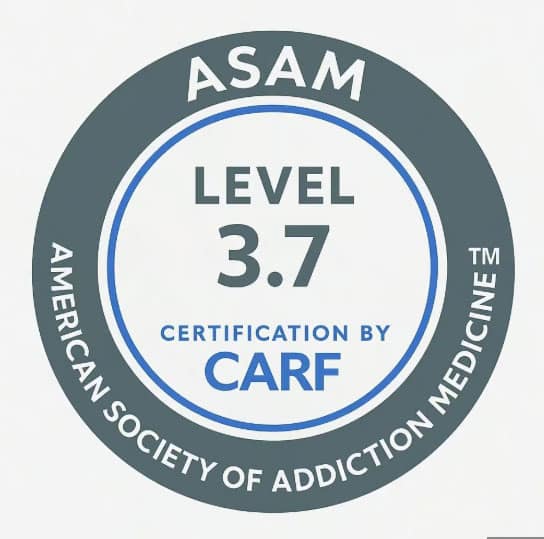Speak to an Admissions Specialist Today!
Call us at (888)-680-1356 or fill out a confidential form.
Wondering how long does weed stay in your system? The duration that weed stays in your system depends on several factors like frequency of use, body fat, and the type of test used. In this article, we’ll explore how long THC, the active compound in marijuana, remains detectable in your body and the different testing methods used to identify its presence.
Key Takeaways
- THC is rapidly absorbed into the bloodstream and metabolized in the liver, leading to varying detection times based on usage patterns and consumption methods.
- Detection windows for marijuana vary significantly by testing method: saliva tests detect use within hours, urine tests can last several weeks, hair tests for up to three months, and blood tests for about 36 hours, depending on the half lives of THC in the body.
- Factors like body fat percentage, frequency of use, and metabolic rate significantly influence how long THC remains detectable in the body, impacting detox and addiction treatment.
How the Body Processes THC

When you smoke marijuana, THC is rapidly absorbed into your bloodstream, reaching peak levels within 6 to 10 minutes, initiating the body process of metabolizing THC. This swift absorption is why the effects of smoking marijuana are felt almost immediately. On the other hand, when THC is ingested orally, such as through edibles, the absorption process is slower, leading to delayed but prolonged effects.
Once THC enters your body, the body processes THC through a complex metabolic process primarily in the liver. Here, THC is converted into 11-OH-THC, an active metabolite, and then further broken down into 11-COOH-THC, an inactive compound. These metabolites are what drug tests typically detect, as they remain in the body long after the initial effects of marijuana have worn off.
THC’s fat-soluble nature means it tends to accumulate in fatty tissues. This is particularly significant for chronic users, as THC can build up in fatty tissues faster than it can be eliminated. As a result, THC can remain detectable in the body for extended periods, sometimes ranging from 5 to 13 days in frequent users. This accumulation and slow release from fatty tissues explain why THC has such prolonged detection times compared to other substances.
Duration of Weed in Your System

The duration that marijuana stays in your system can vary widely depending on many factors. Generally, the complete elimination of marijuana from the body can take anywhere from 5 to 65 days. This wide range is influenced by usage patterns, with infrequent users typically clearing THC faster than frequent users.
The half-life of THC, which is the time it takes for half of the THC to be eliminated from the body, also varies depending on how much cannabis is consumed. For infrequent users, the half-life is approximately 1.3 days. However, for frequent users, the half-life can range from 5 to 13 days.
Additionally, the method of consumption plays a role, with smoking leading to shorter detection times compared to edibles. Individual hydration levels can also impact how quickly THC is eliminated from the body.
Saliva Test Detection Times
Saliva tests are a popular, non-invasive method for detecting recent marijuana use, as THC can be detected in the system quickly after consumption. These tests can identify THC presence typically within hours of use and generally reflect consumption shortly after ingestion. However, the detection window for saliva tests is relatively short, usually up to 24 hours.
This makes them ideal for detecting recent use but less effective for identifying long-term marijuana consumption.
Urine Test Detection Times
Urine tests are the most commonly used method for marijuana drug testing, particularly in employment settings. They are favored because they are easy to administer, relatively non-invasive, and have a longer detection window compared to saliva tests. For a single use of marijuana, THC can be detected in urine for up to three days. However, for frequent users, this detection window can extend to several weeks due to the accumulation of THC metabolites in the body.
Many employers require drug tests as part of their hiring process or workplace policies. These tests can occur before employment, after incidents, or randomly, and they may screen for various substances, including marijuana. Besides urine tests, other methods like blood and hair tests can also be used, but drug screen tests remain the preferred choice because of their balance between detection window and practicality.
Hair Test Detection Times
Hair tests have the longest detection window of all the drug testing methods, capable of identifying marijuana use for up to three months due to the presence of THC metabolites in hair follicles. This is because THC metabolites get incorporated into the hair shafts as they grow, providing a long-term record of drug use.
However, it’s worth noting that first-time users may not test positive in hair tests if the usage occurred within the last 7 to 14 days, as THC takes time to build up in hair growth.
Blood Test Detection Times
Blood tests are typically used to detect recent marijuana use, as THC reaches the bloodstream quickly and is present for a shorter duration compared to other testing methods. THC can be detectable in blood for up to 36 hours after use, with chronic users potentially extending this period to seven days, as THC reaches peak levels shortly after consumption. For most people, THC is generally detectable in blood tests for up to 12 hours after use.
Despite their shorter detection window, blood tests are highly accurate and can provide a clear indication of recent marijuana use. They are often used in situations where immediate impairment needs to be assessed, such as in traffic stops or workplace accidents to detect marijuana.
Factors Influencing Marijuana Detection

Several factors can influence how long weed stays in your system, making marijuana detection a complex process influenced by other factors. One of the most significant factors is body fat percentage. Because THC is fat-soluble, it tends to accumulate in fatty tissues, leading to longer detection times in individuals with higher body fat percentages. Additionally, understanding how long weed stay in your system can help users make informed decisions.
Another critical factor is the frequency of marijuana use. Frequent users are more likely to have THC metabolites lingering in their system for extended periods compared to infrequent users. Metabolic rate also plays a crucial role in THC elimination; individuals with faster metabolisms can break down and remove THC more quickly.
Additionally, factors like age, gender, and overall health can influence THC metabolism. Older individuals or those with compromised health may metabolize THC more slowly, leading to longer detection times. Gender differences in body fat composition can also affect how long THC remains detectable in the body, similar to many drugs.
The Impact of Body Fat on THC Retention

THC’s fat-soluble nature significantly impacts its retention in the body, leading to higher THC concentrations in individuals with higher body fat percentages. Individuals with higher body fat percentages tend to retain THC for longer periods because THC binds to fat cells. This binding leads to prolonged detection times, as THC is slowly released from these cells over time.
Conversely, individuals with lower body fat percentages can eliminate THC more quickly. Genetic factors and body composition, including body mass index (BMI), can also impact how efficiently THC is metabolized and eliminated from the body.
Detoxing from Marijuana

Detoxing from marijuana involves eliminating THC from the body, a process that can be challenging for frequent users. To pass a drug test, the most dependable method is to cease using marijuana. This approach ensures you are clear of the substance. However, this can lead to withdrawal symptoms such as irritability, insomnia, and loss of appetite. Does weed affect the detox process?
Staying hydrated and maintaining a balanced diet can help ease the detox process, but it’s important to note that detox kits are not regulated and may not effectively remove THC from the system quickly. Some kits can even cause liver dysfunction and other health issues.
Many tips and tricks to ‘beat’ a drug test, such as excessive water consumption, are not only ineffective but also dangerous. The safest approach to detoxing is to allow the body time to naturally eliminate THC while supporting overall health through proper hydration and nutrition.
Marijuana Addiction and Treatment Options

Marijuana addiction is a real and challenging issue for many individuals, often linked to drug abuse and substance abuse. Symptoms of addiction include withdrawal symptoms, building tolerance, and continuing use despite negative consequences. Self-detox can increase the risk of relapse due to uncomfortable withdrawal symptoms.
Professional treatment options are available to help manage both the physical and psychological aspects of addiction. Facilities like American Addiction Centers provide comprehensive treatment services, addressing both mental health and addiction issues. Medical detox programs provide essential support, and facilities like Ritz Recovery in Los Angeles offer comprehensive treatment services.
Symptoms of Marijuana Addiction
Common symptoms of marijuana use disorder include:
- Experiencing withdrawal symptoms
- Building tolerance
- Challenges in work or school
- Struggling to control use
- Continuing use despite negative consequences
These symptoms can lead to adverse personal and social consequences.
Treatment Programs at Ritz Recovery
Ritz Recovery offers personalized treatment plans that address both physical and psychological aspects of addiction. One effective approach is contingency management, which uses rewards to incentivize abstinence from marijuana addiction treatment.
Sober living homes provide a supportive environment to help residents maintain sobriety, and aftercare services assist individuals in maintaining their recovery after completing initial treatment, often with the support of a primary care companion.
Legal Aspects of Marijuana Drug Testing
The legal landscape of marijuana drug testing is complex and varies by location. Federally, cannabis is classified as a Schedule I substance, with data from the National Institute on Drug Abuse highlighting its potential for abuse. However, some federal agencies have relaxed their screening policies for cannabis, indicating a shift in approach to drug testing.
Most employers can legally test employees for cannabis use, depending on their location, employer policies, and the nature of the profession. The Substance Abuse and Mental Health Services Administration provides guidelines and resources for understanding these regulations. Currently, there is no reliable test for determining impairment due to cannabis use, and breath tests for THC impairment require more research.
Employment Drug Testing Policies
Employment drug testing policies can vary widely, and many employers require drug tests before hiring new employees. Many employers still conduct drug testing for cannabis before hiring new employees, and some even conduct random drug tests based on state laws and specific employment conditions.
Employers must have reasonable suspicion of drug use at work to initiate testing. This requirement is based on the need for justification before conducting drug tests. In states where marijuana is legal, individuals can still be terminated for failing a drug test.
Medical Marijuana and Employment
Employees using medical cannabis cannot be discriminated against or disciplined for their medicinal use in several states. States like California, Minnesota, Nevada, New York, and Washington, D.C. have dropped pre-employment cannabis screening for public jobs.
Employers have the authority to adjust job responsibilities for employees who use medical cannabis. This can help ensure that employees can perform their duties safely while accommodating their medical needs, even if they have a positive drug test for cannabis.
Summary
Understanding how long weed stays in your system is crucial for various reasons, from passing a drug test to managing weed use and marijuana addiction. Factors such as body fat, frequency of use, and individual metabolism all play a role in THC detection times. Detoxing from marijuana requires patience and proper support, and professional treatment options are available for those struggling with addiction.
If you or someone you know is dealing with marijuana addiction, seeking help from facilities like Ritz Recovery can provide the necessary support to overcome this challenge. Remember, the journey to recovery is a step-by-step process, and there are resources available to help you along the way.
Frequently Asked Questions
How long does marijuana stay in your system?
Marijuana can remain in your system for 5 to 65 days, influenced by factors such as frequency of use and individual metabolism. It’s important to consider these variables if anticipating a drug test.
What is the best way to detox from marijuana?
The most effective way to detox from marijuana is to cease usage and enhance your body’s recovery through proper hydration and nutrition. This approach supports your overall well-being during the detox process.
What are the symptoms of marijuana addiction?
Marijuana addiction manifests through symptoms such as withdrawal, increased tolerance, difficulties in academic or professional settings, and ongoing use despite adverse effects. These signs indicate the need for attention and support.
Can employers test for marijuana use?
Yes, employers can test for marijuana use, particularly in safety-sensitive positions where employee impairment could pose a risk.
What treatment options are available for marijuana addiction?
Treatment options for marijuana addiction encompass medical detox programs, behavioral therapies such as contingency management, and supportive environments like sober living homes. Each option aims to provide a comprehensive approach to recovery.








